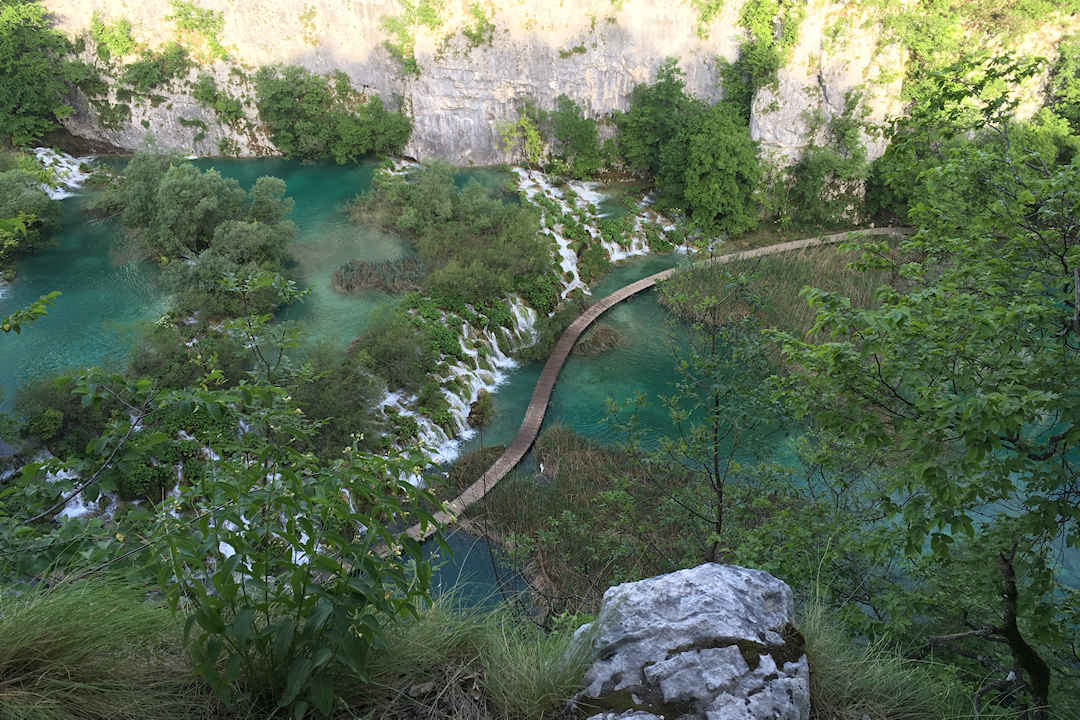A UNESCO World Heritage Site since 1979, Plitvice Lakes / Plitvička Jezera National Park [Official website, Google Maps location] is one of the most popular tourist attractions in Croatia. And for good reason: the lake terraces are easy to explore and stunning – Mother Nature at her best.
Like Dubrovnik though, the park does get (over)crowded during the summer months, which can result in a less than pleasurable experience. If you’d like to visit Plitvice Lakes National Park independently and wonder how to organise your trip to avoid the big tourist crowds, this guide is for you. We give you all the tools you need to have a terrific experience.
Download your Sustainable Travel Checklist and show the world you care
As travellers, we should all be aware of our travel behaviour and its environmental, economic and social impact; and make conscious decisions about it. Too often, we hear negative stories in the media about tourists behaving badly.
Here is your chance to tick some boxes and check out what it really takes to travel with a sustainable mindset.
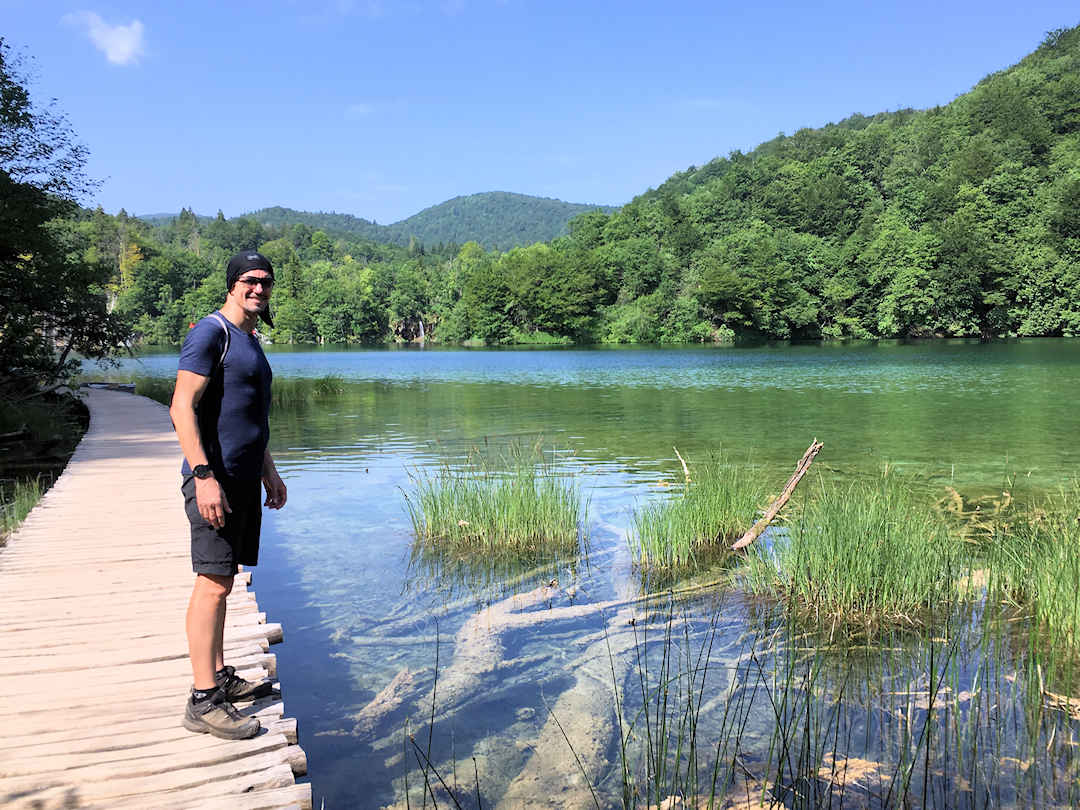
The Plitvice Lakes are easy to visit independently. We give you all the tools you need to organise your trip and avoid the tourist crowds.
Map of Accommodation, Points of Interest, Eateries and Transport
Below is a map of the recommended accommodation, points of interest, eateries and transport terminals/stops mentioned in this article.
It includes the recommended routes to give you the best experience and facilitate the management of crowds. If you enter via Entrance 1, there are four routes to choose from – A, B, C and K1. If you enter via Entrance 2, you can select between E, F, H and K2.
Why is Plitvice Lakes National Park so popular?
Admittedly, we have a soft spot for waterfalls. We swam in Semuc Champey [Google Maps location] in Guatemala, admired Iguazu Falls / Cataratas del Iguazú [Google Maps location] from both the Argentinian and Brazilian sides and visited many other beautiful waterfalls around the world.
So trust us when we say: Plitvice Lakes National Park is very special. The park’s waterfalls connecting the 12 upper and 4 lower lakes are astounding. Of amazing emerald green to turquoise colour (depending on the time of year and day), the lake terraces end in yet another impressive waterfall, Sastavci Slap, and from there, the gushing water continues to flow as the Korana River.
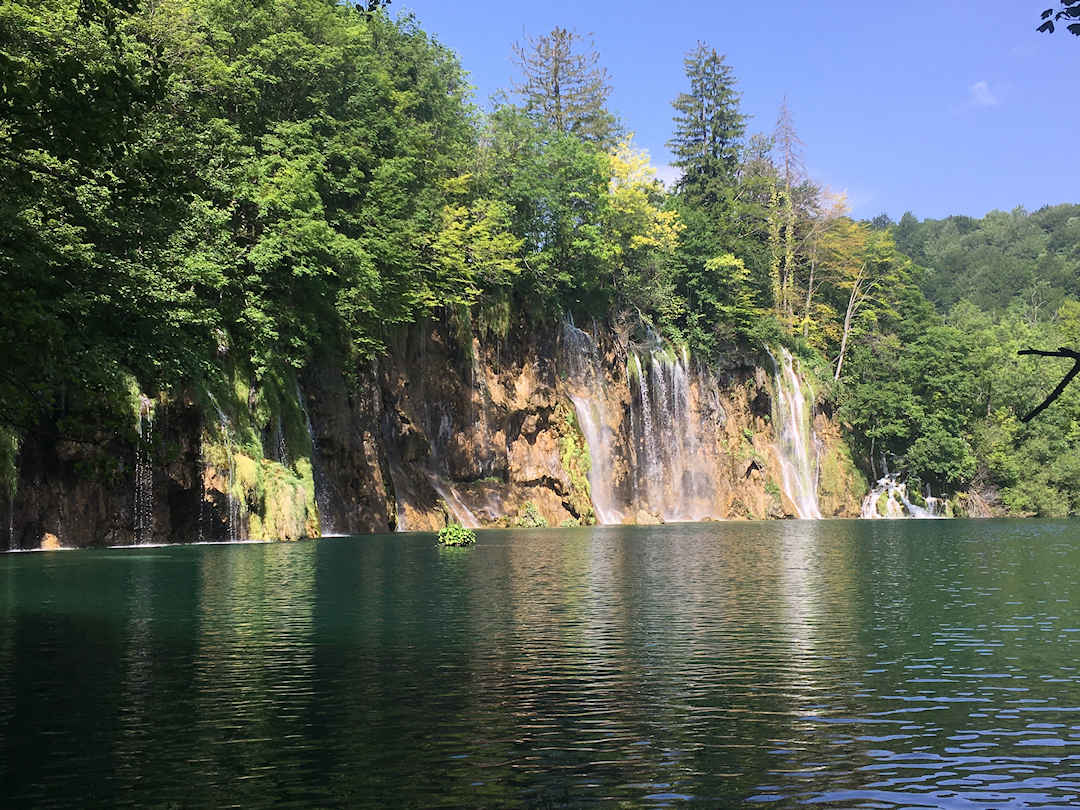
This is what so many people come to see: the emerald green waters of the lakes and waterfalls at Plitvice
Just under 300 square kilometres in size, Plitvice Lakes National Park is Croatia’s largest National Park. It is also its oldest, and with about 1.2 million visitors in 2022, one of Croatia’s most visited. Plitvice Lakes together with Dubrovnik’s city walls are probably THE most well-known (and most photographed) tourist attractions in Croatia. The lakes are not only incredibly picturesque but also reasonably accessible, with day tours available from Zagreb (approximately 2 hours’ drive) and even from Split (approximately 3 hours’ drive).
While you can visit Plitvice Lakes National Park on one of these day trips we strongly advise against it. Not only will you spend more time travelling on the bus than in the park, but you will experience the park when it is most crowded, and you will only have the chance to see a small portion of the park. Do yourself the favour and take your time. The Plitvice Lakes National Park is worth it.
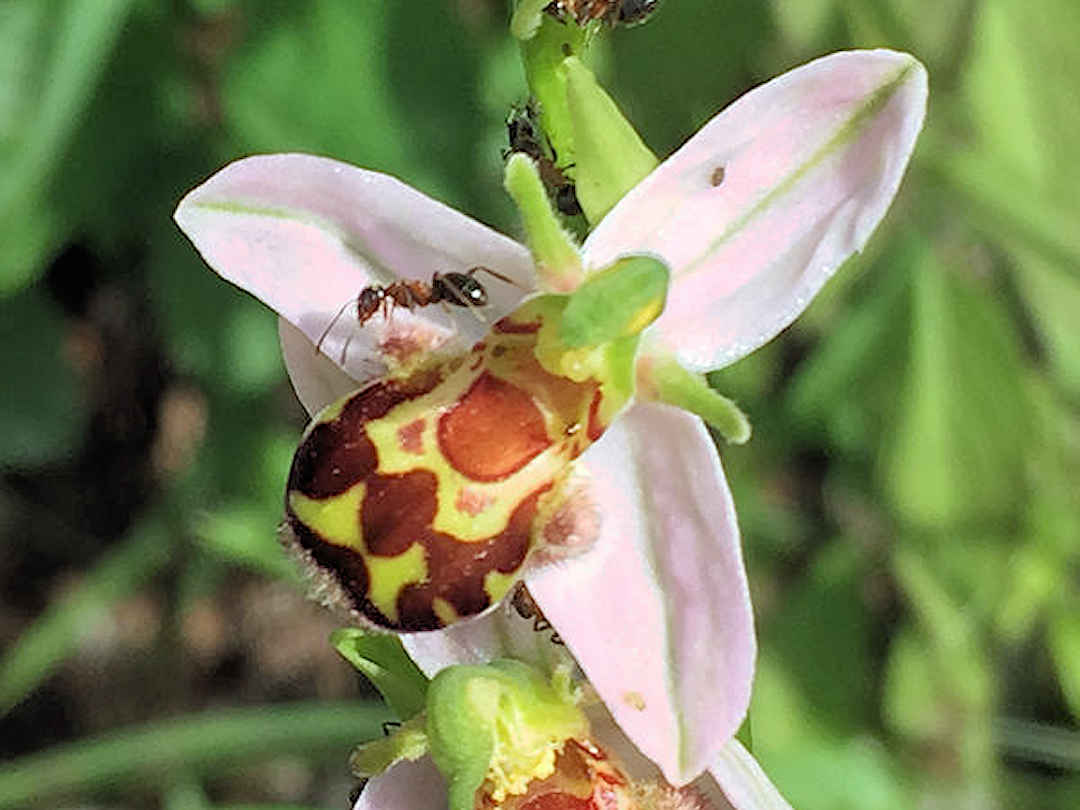
Take your time exploring the park. There is so much to see.
Which National Park is better – Plitvice Lakes or Krka?
Both parks are very different, and we don’t think they are comparable. If you have time to visit both, do so. If you’ve only got time for one we recommend starting with Plitvice Lakes National Park and visiting Krka National Park another time.
Why? The main sights in Krka National Park are more spread out, and if you want to explore most of the park you need more time (especially if you don’t have a car). Plitvice Lakes National Park is easy to explore as the main sights are concentrated in a single area. And apart from well-maintained trails, visitors can use special road trains and electric boats to explore the park. The downsides of Plitvice Lakes National Park (at least for some visitors):
- Cycling is not allowed in the park.
- For such a long-running tourist attraction, there is a surprising lack of sustainable and affordable food options in the park.
If you want to visit both (during the same trip) and are looking for an order we suggest visiting Krka National Park first and then Plitvice Lakes National Park.
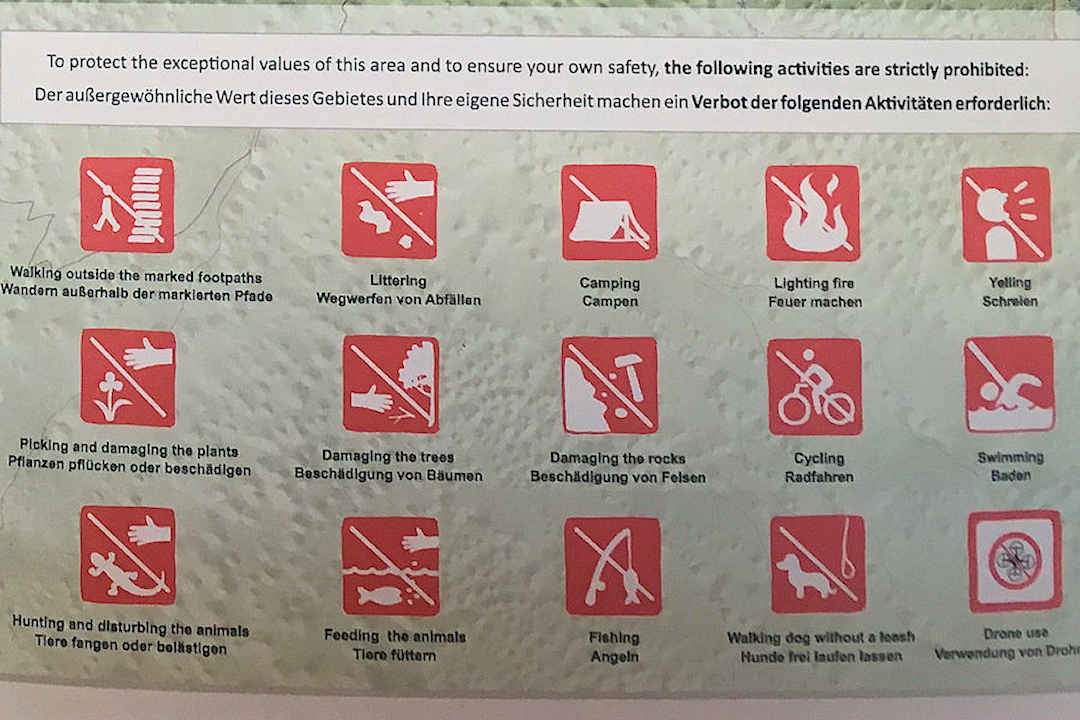
Plitvice Lakes is easier to explore than Krka National Park but some activities you can do at Krka are prohibited at Plitvice Lakes
When is the best time to visit Plitvice Lakes?
We already mentioned it: avoid the busy summer months, especially July and August, if you can. Not only is it very hot, and you share (especially the most popular sights of) the park with thousands of other visitors. Entry prices are also the highest between June and September. Furthermore, given the number of visitors entering the park per day/hour is restricted, in summer, you are more likely to find your prefered entry day/slot to be sold out (more on that below).
Entry tickets are cheapest in the winter months between November and March. If you’re after more pleasant temperatures and fewer crowds we suggest visiting in the shoulder season, April/May and October.
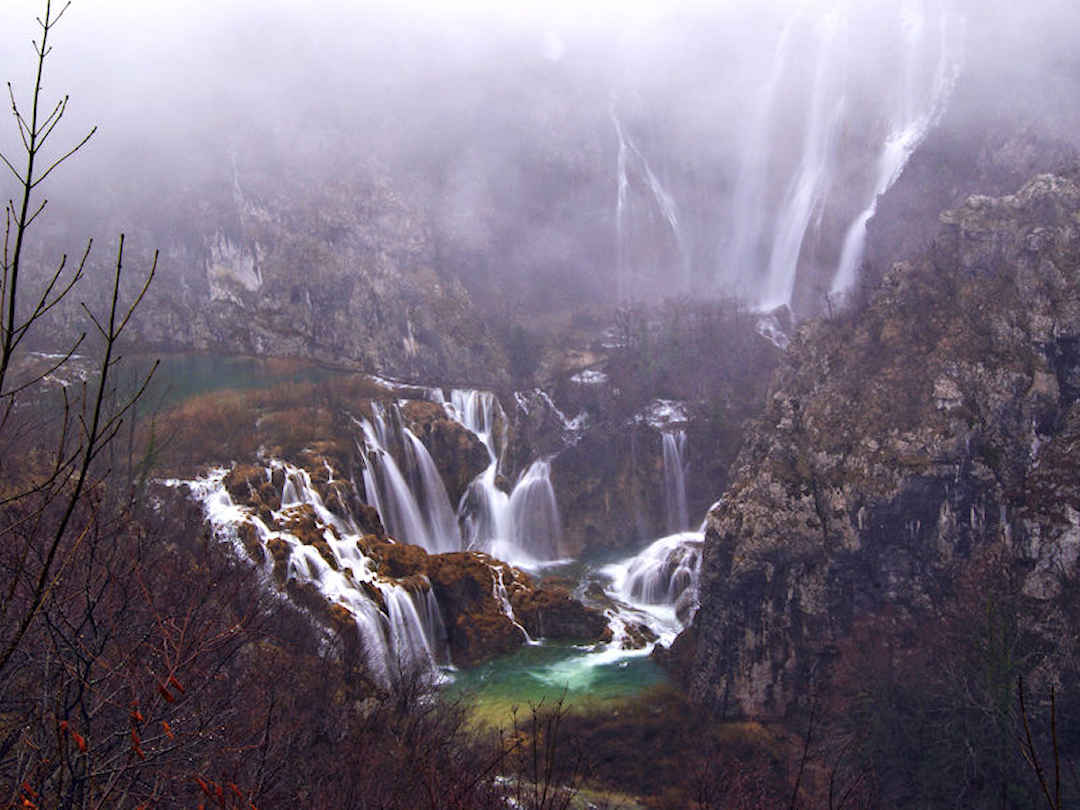
Plitvice Lakes National Park is worth a visit any time of the year, even in winter | Photo by Shawn Appel on Unsplas
How to get to Plitvice Lakes National Park (without a car)
Location and access
Plitvice Lakes National Park is located in the centre of Croatia, close to the border with Bosnia and Herzegovina, another state of the former Socialist Federal Republic of Yugoslavia.
From south to north, and descending from 636 to 502 metres above sea level, the lake terraces that make up the most visited portion of the Plitvice Lakes National Park span 8 kilometres. The park therefore has two official entrances, about 3 kilometres apart from each other along state road number 1:
- Entrance 1 [Google Maps location] is the park’s northern entrance. It is closest to the Lower Lakes section of the park.
- Entrance 2 [Google Maps location] is the park’s southern entrance. It is closest to the section of the Upper Lakes.
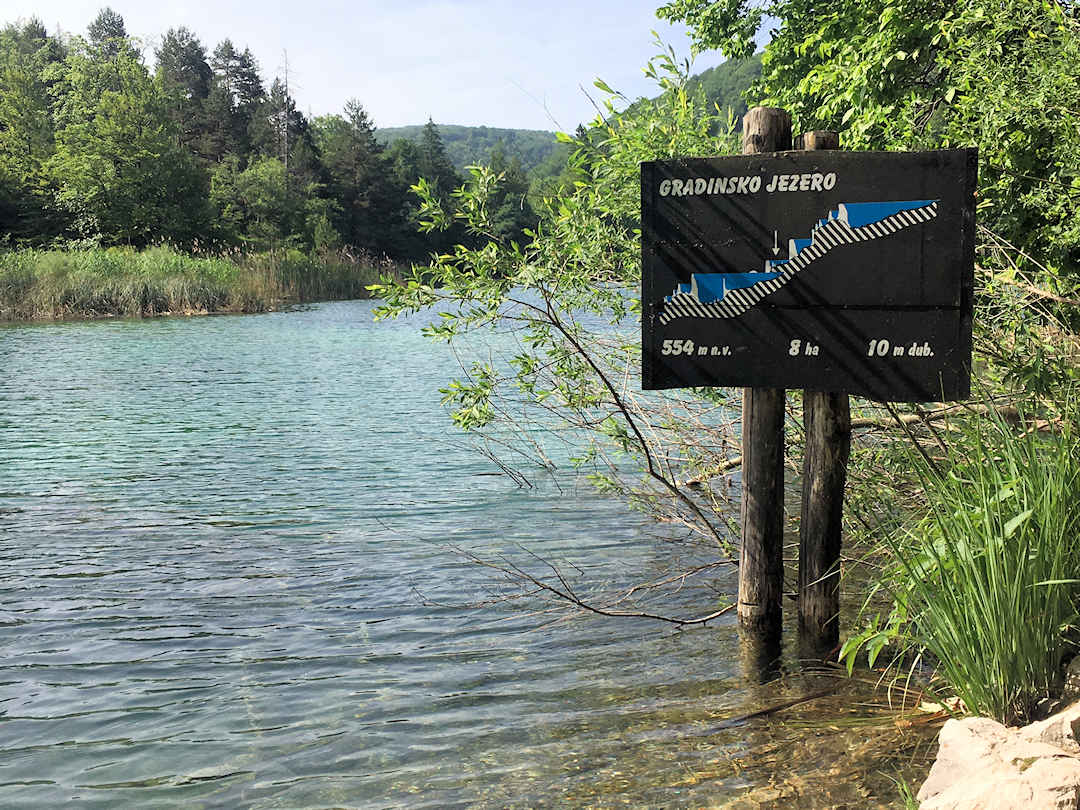
Spanning 8km from south to north, the lake terraces descend from 636 to 502 metres above sea level
Travel by bus
Buses from Zagreb or Zadar take about 2 to 2.5 hours. Buses stop at either entrance. You can buy your onward/return bus ticket/s from the little huts at either bus stop.
Travel by car
Both entrances have large parking lots (and parking is free of charge). However, most tour buses park at (and thus most day visitors enter through) entrance one. In other words: entrance two is the slightly less busy one.
How to get around the park, and what are the trails like?
Plitvice Lakes National Park has more than 20 kilometres of well-maintained boardwalks and hiking trails, connecting all 16 lakes (and there are more trails in the remoter parts of the park):
- The boardwalks allow visitors to see the fascinating waterfalls close up. Essentially interconnected wooden platforms on stilts, built over the lakes and waterfalls, the boardwalks have (largely) no side barriers. If you misstep, you’re in the water. So watch your steps, especially when taking photos.
- Hiking trails allow visitors to walk/hike along the lakes, sometimes right along the lake shores, sometimes high above, on cliffs that provide stunning vistas over the lakes. The hiking trails lead through the forest but are narrow and can be uneven and muddy during rainy periods.
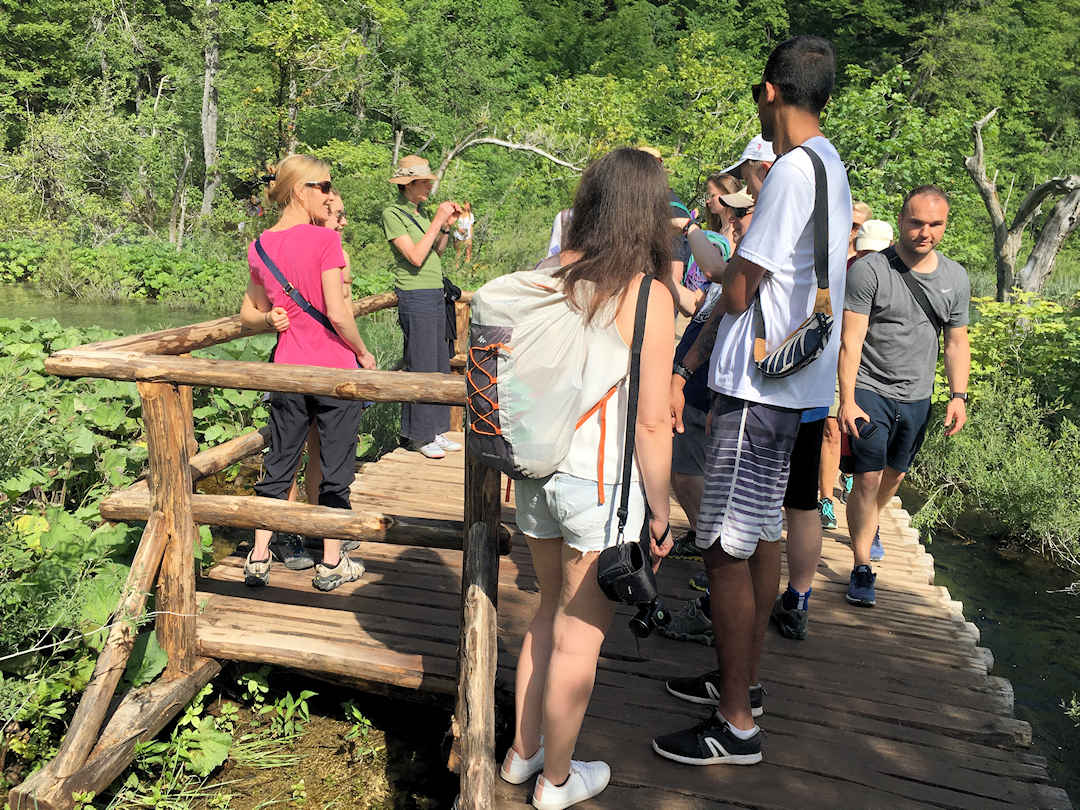
Boardwalk platforms with side barriers like this are rare, so watch your steps
The park management provides a number of trail options (or programs) from both entrances for visitors exploring the main sights of the park on their website, with trails ranging from 3.5 kilometres (program A) to 12.5 kilometres (program K2).
Choose the most suitable one/s out of those trails OR follow our tried and tested route – more on that below.
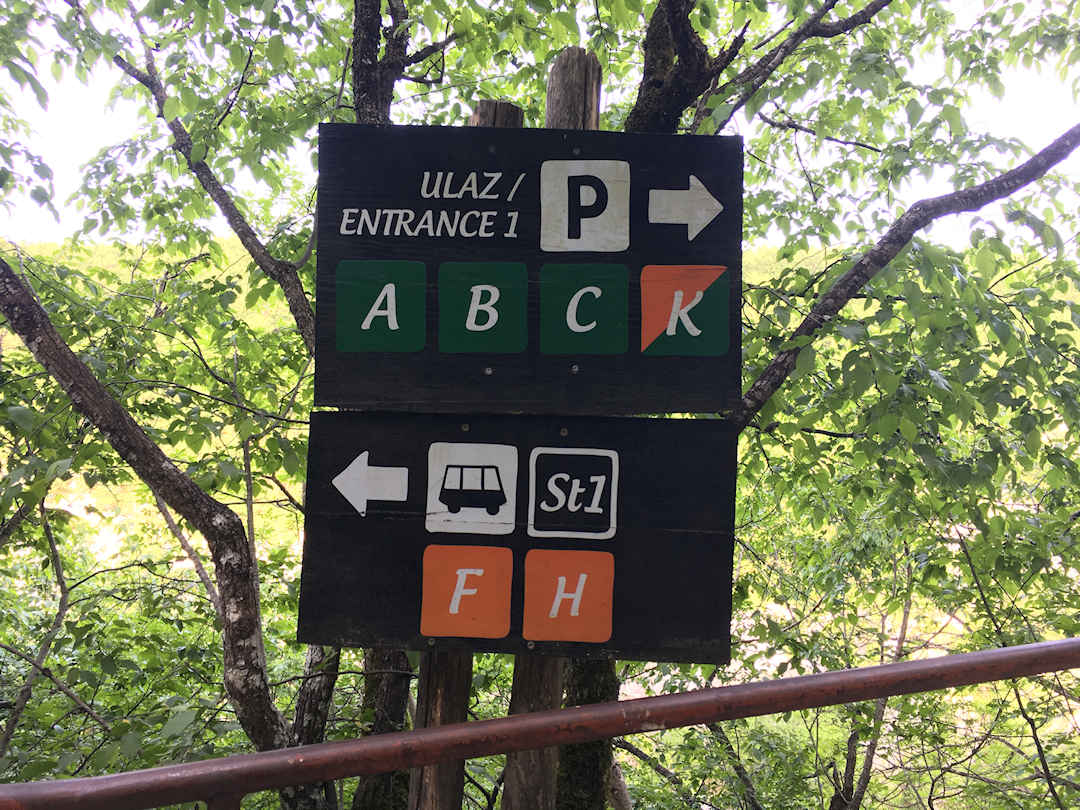
Trail markers like this one are dotted all around the park, so you can't get lost
Due to the nature of the boardwalks and trails, accessibility by wheelchair or with a stroller is limited. If you are visiting with infants or toddlers and want to see more of the park we recommend carrying them in a baby carrier.
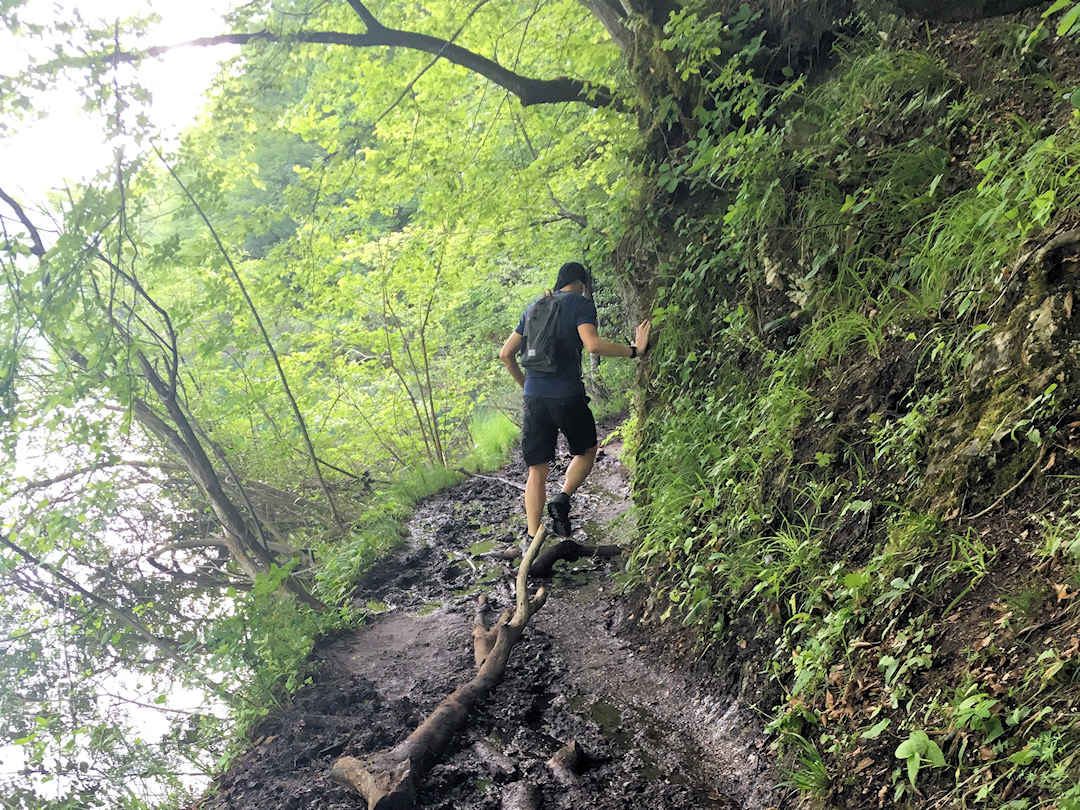
Trails around the lakes can be muddy during and after rainy periods
If you’re not a big walker/hiker, have mobility issues or limited time, there are also
- electric boats that cross the largest of the lakes (Lake Kozjak), and
- road trains that connect the most remote upper lakes with the two entrances.
Note that the boats and road trains may have different operating hours to the park.
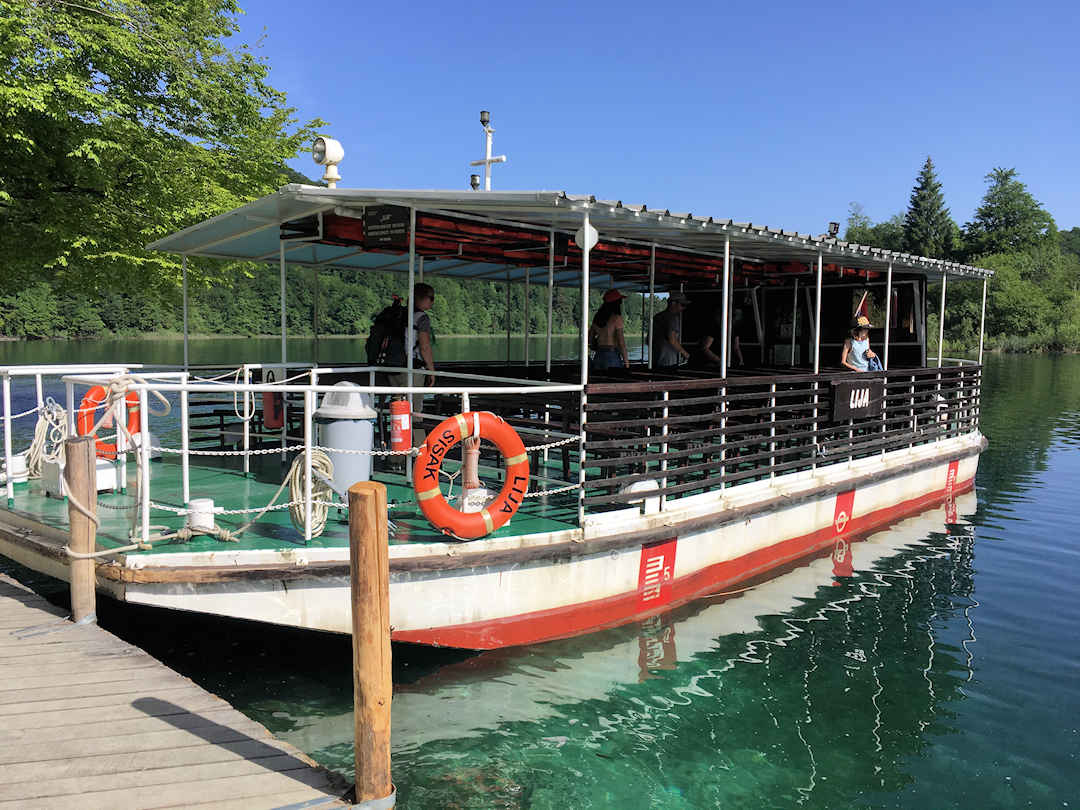
In Plitvice Lakes National Park, electric boats and road trains make more remote areas accessible to people who are less mobile (or just want to skip a few kilometres)
How much time does it take to visit Plitvice Lakes?
We recommend staying at least one night to experience the park in the early morning. That’s when you have the park almost to yourself and may even get to see some local wildlife. Weigh up between
- staying two nights and buying a one-day pass (which gives you a full day), and
- staying one night and buying a two-day pass (which means you could go into the park on the afternoon of your arrival and again the next morning).
We explain the accommodation and ticketing options in more depth below.
If you do decide to explore Plitvice Lakes during a day visit (for example on your way from Zagreb to Split): You can leave your luggage at either entrance while you explore the park.
Are there entrance fees? How does the ticketing work?
To protect the fragile ecology of the park, the park management has restricted the number of visitors allowed in the park at any given time. Entry tickets are therefore valid only for a specific day (or days) AND for a specific entry time (on the first day of your visit if you bought a ticket for multiple days).
While you can buy tickets in person at the entrances, advance online booking is recommended to avoid missing out. You can check ticket availability for the following 24 hours on the Park Management’s website.

Make sure you stay at least one night as in the early morning, you have the park almost to yourself
If you book your tickets online please note:
- Once you have completed your online purchase, you need to store your ticket on your mobile device or print it (and bring it with you when you visit the park).
- The ticket then needs to be validated at the entrance selected during your purchase (from 1/2 hour before to one hour after your stated time slot).
So make sure to pick the right entrance based on your travel plans. And if you’re travelling by bus, make sure you factor in potential delays when you decide on the time slot – our bus from Zagreb was delayed by over 1/2 hour.
Where to stay at Plitvice Lakes National Park (without a car)?
For accommodation, as with any other travel expenses, it’s worth shopping around. When we booked our accommodation, we looked across several booking platforms to find the best value-for-money option but found in this case that Booking.com offered us the best choice and price point. Wherever you book, do make sure you read the fine print to make sure you compare apples with apples. For example, your stay may incur extra charges (like local tourist taxes or cleaning fees). Some booking platforms include them, while with others, you have to pay them to your host upon arrival.
Below are my recommendations for accommodation options that fit the criteria of affordable, often meeting a sustainability certification, and that are close to public transport and points of interest.
| Name | Property Features | Type | Price Indicator | Book Now |
|---|---|---|---|---|
| Apartman Plitvice Happy Home | 1km from Entrance 2, 5.6km from Entrance 1 Quality rating: 4/5 according to Booking.com | Two bedroom apartment | $$ | Book Now |
| B and B Villa Plitvica | 950m from Entrance 1 4-stars | Double Room Apartment | $$$ | Book Now |
| Fenomen Plitvice Resort | 700 metres from Entrance 1 4 stars | Studio to Luxury Suites | $$$$$ | Book Now |
| Hotel Jezero | 400m from Entrance 2, 2.3km from Entrance 1 3-stars 2 restaurants Spa and wellness centre | Hotel | $$$$ | Book Now |
| L and L Leisure Apartments Plitvice | 900m from Entrance 2, 3.6km from Entrance 1 4-stars | Apartment | $$$ | Book Now |
| Plitvice Lower Lakes Rooms | 950m from Entrance 1 | Guesthouse | $$$ | Book Now |
| Up27 Suites | 900m from Entrance 2, 3.6km from Entrance 1 4-stars | Apartment | $$$ | Book Now |
| Apartments Sven | 700 metres from Entrance 1 3-stars Fully equipped kitchen | Apartment | $$ | Book Now |
| House Biba and Leona | 950m from Entrance 1 3-stars | Guesthouse | $$$ | Book Now |
| House Flora | 600m from Entrance 1, 3-stars | Guesthouse | $$$ | Book Now |
| House Milan | 650m from Entrance 1,, 3-stars | Studio Apartment | $$ | Book Now |
| Plitvice Airbnb | 650m from Entrance 1 | Large studio room with kitchenette and ensuite bathroom | $$$ | Book Now |
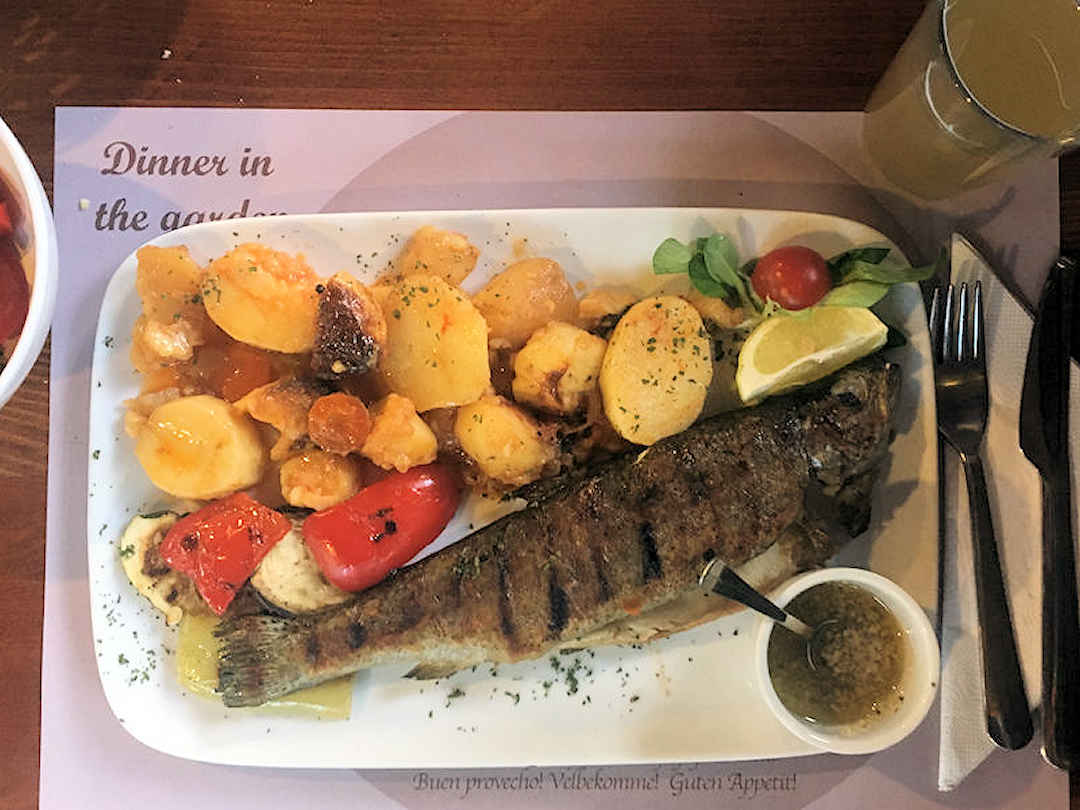
We stayed in Rastovača near entrance 1 with self-catered breakfast, some snacks for lunch and delicious dinner at nearby House Katarina
Where to eat at or near Plitvice Lakes National Park
Dining options are limited to the three hotel restaurants and Restaurant Poljana. The park lacks decent food options and water fountains. Bring your own snacks and water bottle. Bins are only located at the boat and road train stops, so ensure you carry your rubbish until you can dispose of it.
Dining options are limited to (pre-arranged) dinner/s at your accommodation (where available) or:
- a small (seasonal) garden restaurant at House Katarina [Google Maps location];
- Restaurant Lička Kuća [Google Maps location]; and
- Restaurant Petar (Google Maps location].
There is no supermarket nearby. So make sure you bring your food with you (from Zagreb or wherever you travel from) if you want to self-cater.
Plitvička Jezera
Dining options again are limited, with Pizzeria Vučnica [Official website, Google Maps location] the only viable option. However, there is a small supermarket called Robni Centar [Google Maps location] for those who want to self-cater.
Plitvica Selo
Dining options are also limited, with the Etno Garden Restaurant and Restaurant Kozjak the most viable (but expensive) options. There is no supermarket nearby.
In walking distance from entrance 2 (settlement of Plitvička Jezera)
A bit further away, at around 20 minutes walk, are the guest houses and apartments in the settlement of Plitvička Jezera, for example
Dining options again are limited, with Pizzeria Vučnica [Official website, Google Maps location] the only viable option. However, there is a small supermarket called Robni Centar [Google Maps location] for those who want to self-cater.
In Plitvica Selo (a small settlement near the Great Waterfall)
We mention this option for completeness, though we do not recommend staying in Plitvica Selo unless you have a car as it is more cumbersome to get to/from. Our accommodation recommendations in Plitvica Selo include:
Dining options there are also limited, with the Etno Garden Restaurant and Restaurant Kozjak the most viable (but expensive) options. There is no supermarket nearby.
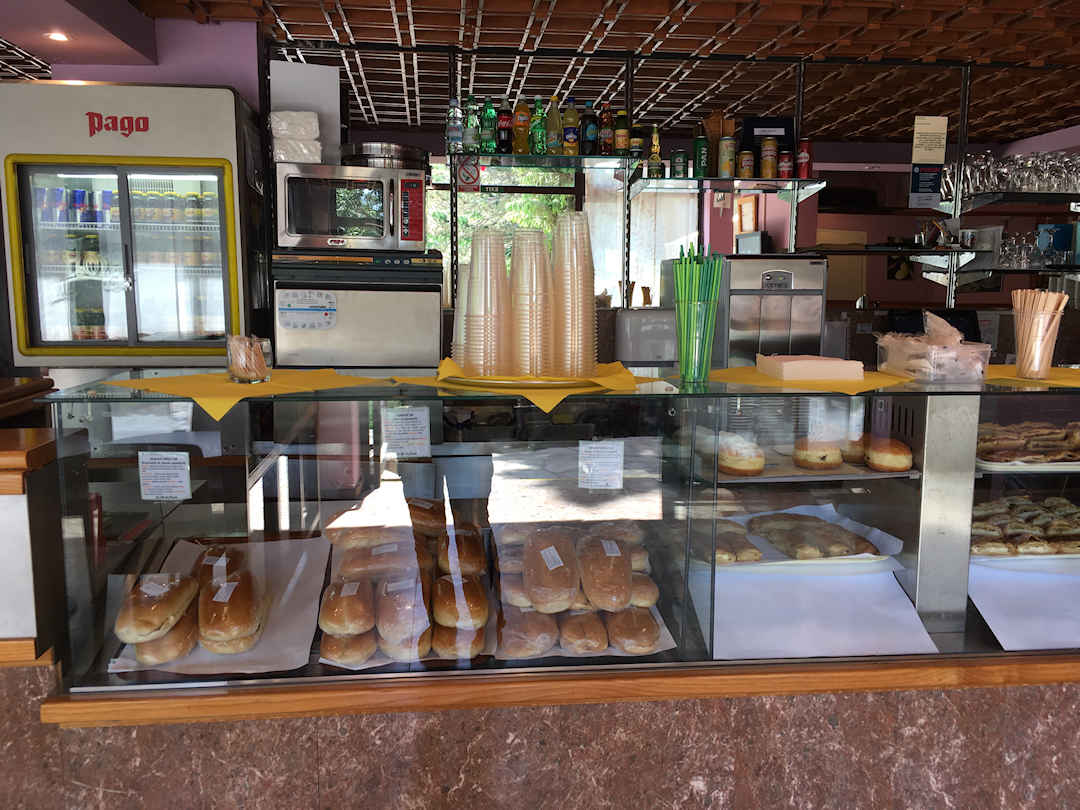
Bring enough food for your visit - The park lacks decent food options and the only grocery store in walking distance is in Plitvička Jezera
Visit Krka without the crowds (or a car) – Sustainable Travel Advice
Croatia’s other major National Park – Krka can also get packed. But you can avoid the tourist crowds. And you can visit without a car too. We show you how in our other guide.
How to see most of Plitvice Lakes without the big tourist crowds?
We explored Plitvice Lakes National Park over two days and walked all the different trails around the lakes (that’s 21km). Don’t worry you don’t need to walk that much (unless you really want to). We’ve put together the below recommendations based on what we would have done with the benefit of hindsight.
Our routes include all the important sights (and photo opportunities) the National Park has to offer, while avoiding the worst of the crowds and limiting backtracking. The routes get you to the same spots (just from different entrances). They also include a (optional) quiet, relaxing early morning walk along the western lake shore that allows you to observe the park’s wildlife: We saw turtles sunbathing, mice foraging, as well as frogs, birds (beyond the omnipresent ducks), crayfish, and too many dragon flies to keep count of.
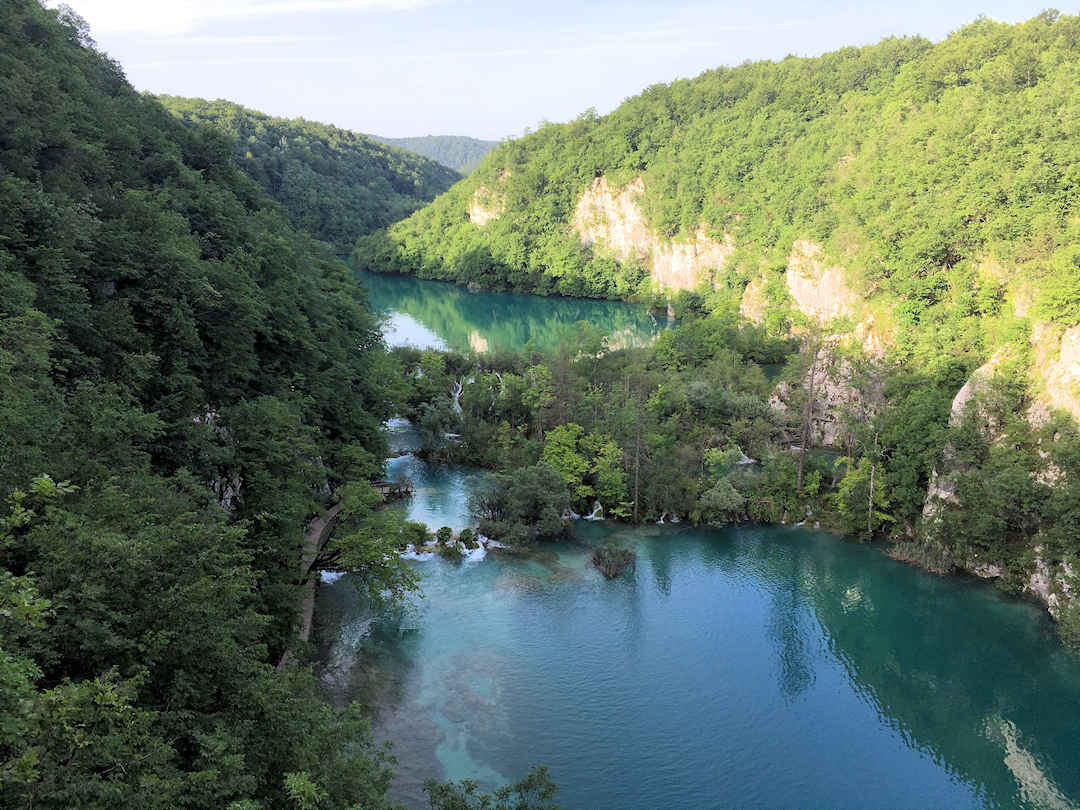
Observe Plitvice Lakes' wildlife on a quiet, early morning walk along the western lakeshore
Best route from entrance 1
One full day
Total length: 13.6km (9.8km minus optional component)
Minimum walking time: ~4 hours (~3 hours)
- Follow program B from entrance 1 to P3 (2.4km), skipping the Great Waterfall (for now) but travelling along the boardwalk and over the bridge. Take the boat from P3 to P2. Optional: Instead of taking the boat, follow program K1 from P3 along the western lake shore to P2 (3.8km).
- From P2, follow program C to St3 (3.8km).
- Take the road train from St3 all the way to St1.
- Walk from St1 down the path towards P3, cross the bridge (the same one you crossed in the morning) but then turn right at the earliest opportunity.
- Walk up the road, then turn right onto the western ridge trail which overlooks the lower lakes. Re-join the road just before you reach the Great Waterfall and cross the wooden bridge above the Great Waterfall. Turn right after the bridge and walk to the viewpoint.
- Return back over the wooden bridge and left onto the western ridge trail. Then take the steps down to the bottom of the Great Waterfall.
- Return from the Great Waterfall to entrance 1, following (reverse) program B (3.6km).
Two half days
Afternoon – Lower Lakes
Total length: 4.7km
Minimum walking time: ~1.5 hours
- Follow program B from entrance 1 towards P3 along the eastern ridge trail, cross the bridge but then turn right at the earliest opportunity.
- Walk up the road, then turn right onto the western ridge trail which overlooks the lower lakes. Re-join the road just before you reach the Great Waterfall and cross the wooden bridge above the Great Waterfall. Turn right after the bridge and walk to the viewpoint.
- Return back over the wooden bridge and left onto the western ridge trail. Then take the steps down to the bottom of the Great Waterfall.
- Return from the Great Waterfall to entrance 1, following (reverse) program B.
Morning – Upper Lakes
Total length: 11km (7.2km minus optional component)
Minimum walking time: 3-3.5 hours (2-2.5 hours)
- Again, follow program B from entrance 1 to P3 (2.4km), skipping the Great Waterfall but travelling along the boardwalk and over the bridge. Take the boat from P3 to P2. Optional: Instead of taking the boat, follow program K1 from P3 along the western lake shore to P2 (3.8km).
- From P2, follow program C to St3 (3.8km).
- Take the road train from St3 all the way back to St1, and walk from there back to entrance 1 (1km).

Walk along the western ridge trail for breathtaking views of the Lower Lakes
Best route from entrance 2
One full day
Total length: 12.5km (8.7km minus optional component)
Minimum walking time: 3-4 hours (~2.5 hours)
- From entrance 2, head to P1 (0.5km) and take the boat across to P2.
- Continue from P2 to St3, following program E (3.8km). Alternatively: from P2 follow program E initially, then join (reverse) program K2 along the western lake shore to P3 (3.8km), take the boat from P3 back to P2 and then continue from P2 to St3, following program E.
- Take the road train from St3 all the way to St1.
- Walk from St1 down the path towards P3, cross the bridge but then turn right at the earliest opportunity.
- Walk up the road, then turn right onto the western ridge trail which overlooks the lower lakes. Re-join the road just before you reach the Great Waterfall and cross the wooden bridge above the Great Waterfall. Turn right after the bridge and walk to the viewpoint.
- Return back over the wooden bridge and left onto the western ridge trail. Then take the steps down to the bottom of the Great Waterfall.
- Follow program A back to St1 (4.4km). Then take the road train from St1 back to St2 (and entrance 2).
Two half days
Afternoon – Lower Lakes
Total length: 4.5km
Minimum walking time: ~1.5 hours
- Walk from entrance 2 to P1 (0.5km), take the boat to P2 and another boat to P3.
- From P3, walk up the road, then turn right onto the western ridge trail which overlooks the lower lakes. Re-join the road just before you reach the Great Waterfall and cross the wooden bridge above the Great Waterfall. Turn right after the bridge and walk to the viewpoint.
- Return back over the wooden bridge and left onto the western ridge trail. Then take the steps down to the bottom of the Great Waterfall.
- Follow program A to St1 (4km). Then take the road train from St1 back to St2 (and entrance 2).
Morning – Upper Lakes
Total length: 8.1km (4.3km minus optional component)
Minimum walking time: ~2.5 hours (~1.5 hours)
- Walk from entrance 2 to P1 (0.5km) and take the boat across to P2.
- Continue from P2 to St3, following program E (3.8km). Alternatively: from P2 follow program E initially, then join (reverse) program K2 along the western lake shore to P3 (3.8km), take the boat from P3 back to P2 and then continue from P2 to St3, following program E.
- Take the road train from St3 back to St2 (and entrance 2).

Cross the wooden bridge above the Great Waterfall, turn right and voila, you've got this postcard view
What many people don’t know about Plitvice Lakes National Park
Plitvice Lakes, due to its importance as a tourist attraction was heavily fought over during the Croatian War of Independence in the early 1990s. The first victims of the war died at Plitvice Lakes on 31 March 1991. A monument near entrance 2 commemorates the event.
During the war, the villages around Plitvice Lakes witnessed some tragic events, and those travelling along state route number one from/to Zagreb passed through an area (between Karlovac and Plitvice) that was under heavy fire during the war. Even 30+ years later, you can still see bullet hole-covered facades. If you have time, stop at the Homeland War Museum on the outskirts of Karlovac (in the suburb of Turanj) to learn more about this recent time in Croatia’s history.
What advice would you give about Plitvice Lakes National Park?
I wrote this Plitvice Lakes National Park article and guide based on my own personal experience. If you have been to Plitvice Lakes National Park and you have something to add, please feel free to contact me. If you liked my article and tips and found them helpful, I would appreciate it if you could share them with your friends and family via the Share buttons below. Even better, link to the page from your personal blog or social media platforms.

